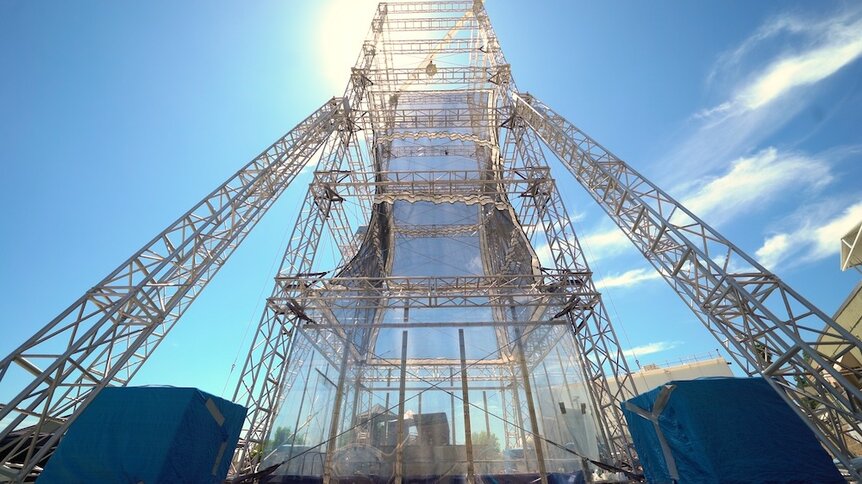Create a free profile to get unlimited access to exclusive videos, sweepstakes, and more!
Future Mars missions might crash land on purpose
Mars or bust.

Red Faction: Origins is a live action movie within the Red Faction series, which is primarily comprised of first-person shooters. The movie takes place between the third and fourth games, detailing the events of a late-21st-century mining colony on the red planet and the violent conflict between the miners and the company which controls them.
One hopes that we actually get to Mars, and if we ever figure out how to live there long-term, things will go a little more smoothly. Before that, however, we’re going to have to land people and supplies on the surface safely. To date, NASA has carried out nine successful landings on Mars, each time delivering a new scientific instrument or rover, but the vast majority of missions are failures. According to NASA, only 40% of all missions ever sent to Mars successfully reached the surface. Those that work, rely on a combination of the atmosphere, parachutes, rockets, and impact absorbing materials to make the trip. Recently, all of those factors have been brought together in a harrowing process commonly known as the seven minutes of terror.
First experienced by the Curiosity rover in 2012, and then again when Perseverance touched down in February of 2021, the seven minutes of terror encompass a complicated entry, descent, and landing process which delivered both rovers from orbit to the ground. It begins when the spacecraft enters the atmosphere at approximately 14,500 miles per hour. Atmospheric drag slows the craft to just under a thousand miles per hour at which point a parachute is deployed. The parachute carries a shell with the rover and the sky crane inside. Once the speed of descent is slowed to about 200 miles per hour the shell and parachute detach, dropping the sky crane and rover. A series of retrorockets fire, holding the sky crane in place as it slowly lowers the rover to the surface on cables. Finally, the sky crane blasts off to crash land far away from the rover’s landing site.
It’s a complicated process with several potential points of failure, and all of it happens entirely out of our control. That’s because the turnaround time on communications with Mars are longer than the landing process itself. By the time we received a signal that something had gone wrong and sent something back, it would be too late.
There’s no denying that the sky crane works, all terror aside, but some scientists and engineers have begun to wonder if there might be a simpler way. Part of Perseverance’s mission involves collecting rock samples from Mars for a future return mission. At the start of the next decade, NASA plans to send a craft to Mars, meet up with Perseverance to collect the samples, and fly them back home. Once it reaches Earth, it’s going to crash land in a deserted location, and we need a way for it to do that without destroying the samples. Thinking about how to make that work on Earth got the team at JPL thinking about if it would work on Mars as well.
To that end, they’ve built the Simplified High Impact Energy Landing Device — also known as SHIELD — which would use a collapsible region similar to a car’s crumple zone to absorb the impact of landing while keeping the payload inside safe. Researchers think it could reduce the cost of landing, result in a higher successful landing rate, and allow for exploration of regions of Mars which are currently inaccessible with our present landers.
To test the premise, the team took their prototype to a 27-meter-tall drop down at JPL and launched it at the ground. The drop tower is equipped with a sling called a bow launch system which hurtles an object at the ground at speeds comparable to a landing on Mars. Before smashing their experimental lander into the ground, they loaded it up with a smartphone, a radio, and an accelerometer as an analogue for any sensitive electronics, instruments, or payloads a Mars craft might be carrying.
The prototype smashed into the ground at about 100 miles per hour (177 kilometers per hour), about the same speed as a Mars lander achieves after atmospheric drag, by the time it reaches the ground. To make the landing even harder, researchers placed a two-inch thick steel plate on the ground in order to simulate a landing more violent than a craft would actually experience on Mars. At the moment of impact, a series of collapsible metal rings crumpled to absorb the force and protect the payload inside.
The onboard accelerometer measured a force of about a million newtons when it hit the ground. It hit so hard that it bounced three and a half feet into the air and flipped. That’s probably because of the metal plate, no bounce was recorded in any previous tests with dirt landing sites. Despite the violent impact, everything inside the lander survived the equivalent of 112 tons smashing into the lander.
Those are forces that would probably turn a living crew into a disconnected pile of bits, but the SHIELD lander did enough to protect its non-living cargo. Crash landing might not be a suitable way to get people to the surface of Mars, but it could help to ensure our stuff gets there undamaged. We’ll just need designated landing sites away from human population centers. Those Martian deliveries are going to come in hot.



























